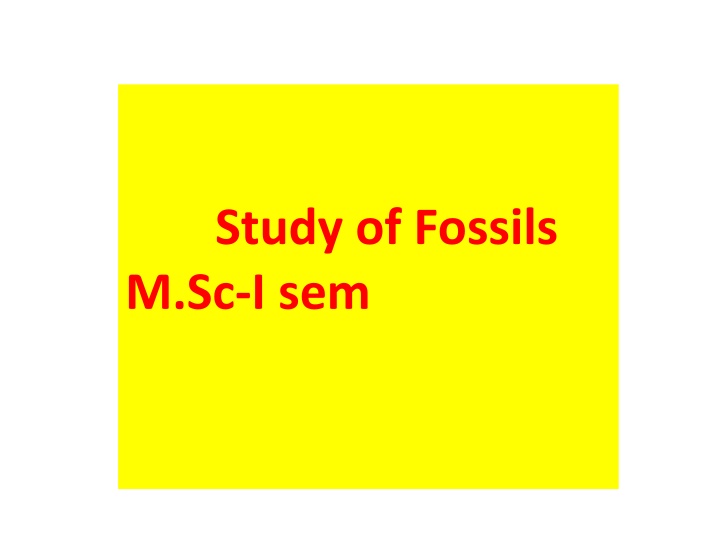
Plant Fossilization Processes and Preservation Conditions
Explore the fascinating world of plant fossils, their various preservation methods, and the conditions required for their formation. Learn about the different types of plant fossils and how they provide valuable insight into past life on Earth.
Download Presentation

Please find below an Image/Link to download the presentation.
The content on the website is provided AS IS for your information and personal use only. It may not be sold, licensed, or shared on other websites without obtaining consent from the author. If you encounter any issues during the download, it is possible that the publisher has removed the file from their server.
You are allowed to download the files provided on this website for personal or commercial use, subject to the condition that they are used lawfully. All files are the property of their respective owners.
The content on the website is provided AS IS for your information and personal use only. It may not be sold, licensed, or shared on other websites without obtaining consent from the author.
E N D
Presentation Transcript
Study of Fossils M.Sc-I sem
Some of the many possible fates of plants or their parts as they enter the fossil record.
The study of how organisms or their parts become fossils is called taphonomy. The fate of most organic material produced by living systems is to be decomposed to carbon dioxide and water, and recycled into the biosphere. The circulation of elements through biogeochemical cycles indicates that decomposition is, indeed, efficient; however the presence of organic material in sedimentary rocks (e.g., coal, petroleum, dispersed organic matter, and fossils) shows that some organic matter - or its traces - escapes these cycles to be preserved in the rock record. The study of paleobotany relies on this preserved material - fossils - as evidence of past life. In the early history of modern paleontology, fossils were thought of mostly as static parts of the rock record ("sticks in mud"). Plants become fossilized in a variety of ways. Each type of preservation carries different information about the once-living organism. Thus, an appreciation of plant fossils requires that one understand the processes of fossilization, and how each type of preservation may influence our view of once-living organisms. Plants become fossilized in a variety of ways. Each type of preservation carries different information about the once-living organism. Thus, an appreciation of plant fossils requires that one understand the processes of fossilization, and how each type of preservation may influence our view of once-living organisms.
Conditions Required for Plant Fossil Preservation.:- Three conditions are required for the preservation of plant fossils are: Removing the material from oxygen-rich environment of aerobic decay; "Fixing" the organic material to retard anaerobic decay; Introducing the fossil to the sedimentary rock record (a.k.a., burial).
Types of Plant Fossils Compressions -- 2-dimensional, with organic material Impressions -- imprints, 2-dimensional, devoid of organic matter Casts and Molds -- 3-dimensional, may have a surface layer of organic material Permineralization -- 3-dimensional, tissue infiltrated by minerals allowing internal preservation Compactions -- 3 dimensional, reduced volume, flattened, wholly organic Molecular Fossils -- non-structural, preserves organic compounds
Era Period Epoch EON Phanerozoic Cenozoic Quaternary Recent/Holocene Pleistocene Pliocene Miocene Oligocene Eocene Paleocene Tertiary Mesozoic Cretaceous Jurassic Triassic Permian Carboniferous Devonian Silurian Ordovician Cambrian Vendian Paleozoic Precambrian Proterozoic Archaean Hadean
Flash Card for different Fossils Mold (imprint) fossils When a leaf, feather, bone or even a body of an organism leaves an imprint on sediment, which hardens and becomes rock Cast fossils When minerals fill in the hollows of an animal track, a mollusk shell, or another part of an organism Fossil fuels Fuels formed by the remains of dead plants and animals Actual remains The body of an organism, with all the parts intact. Usually preserved in ice, amber, or tar. Petrified wood When minerals replace wood or stone to create either petrified wood or a mineralized fossil
Impression of leaves with clay film in the Cretaceous Dakota Sandstone
Permineralised stem of Lepidodendron selaginoides in T.S
Compaction fossil of Halocene Pinus strobes pollen from Asa s Hallow
Petrified forest log : The internal structure of the tree and bark are maintained in the permineralization process.
Sub Fossil----Dodo-Skeleton Natural History Museum London England: Subfossils are often found in depositionary environments, such as lake sediments, oceanic sediments, and soils. Once deposited, physical and chemicalweathering can alter the state of preservation.
An example of a pseudofossil: Manganese dendrites on a limestone bedding plane from Solnhofen, Germany; scale in mm
Three small ammonitefossils, each approximately 1.5 cm across
Petrified cone of Araucaria mirabilis from Patagonia,Argentina dating from theJurassic Period (approx. 210 Ma)
Pennsylvanian coal ball horizons in the Illinois Basin
Jurassic paleosols from the Morrison Formation of Utah.
Carboniferous paleosols from Joggins, Nova Scotia.
Burrowed/backfilled coal of Pennsylvanian age; an example of ichnofossils.
THANKS Dr. Tulika Mishra Deptt of Botany, DDU GU
